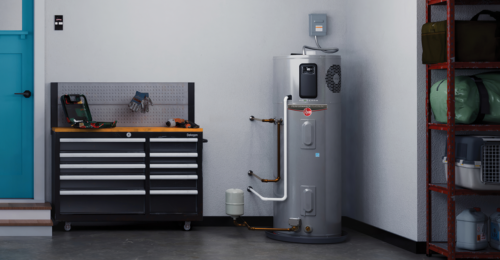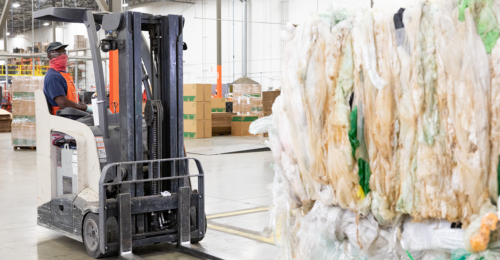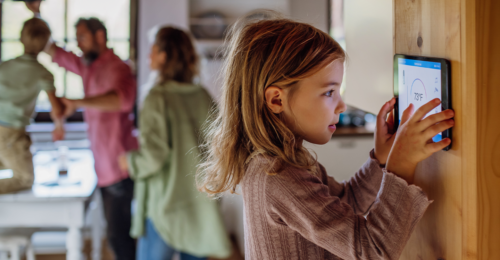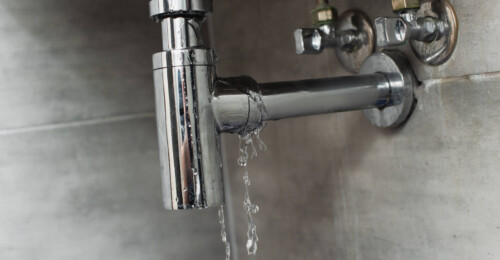Gina Perry has been part of The Home Depot team for over two decades. Today, she is the Senior Product Merchant for Cleaning. We’ve invited Gina to speak with Eco Actions about the changes that the cleaning category has undergone in recent years, how the COVID-19 pandemic has changed the way consumers think about cleaning and what’s on the horizon.
EA: When we think about sustainability in the cleaning department, we primarily think about chemicals and plastics used in cleaning products. How is The Home Depot helping shoppers make informed choices when it comes to cleaning?
GP: The Home Depot’s Chemical Safety Policy and Eco Options product certification program both play a big role in that. Cleaning products listed in our Eco Options program have obtained certifications from independent, third-party testers. These certifications help consumers identify products that are non-toxic, biodegradable, plant-based, not tested on animals and not made with harmful chemicals. They include EPA’s Safer Choice, Cradle to Cradle Certified, USDA-Certified Biobased, SCS Global Services Eco Options Standard and Leaping Bunny Certification.
As consumers have become more interested in environmentally friendly products, The Home Depot has changed the cleaning aisle to make them more accessible and easier to find. We’ve recently launched an eco-friendly bay that is in 300 stores today. In addition to giving green products a space of their own, there is wayfinding signage in place to help shoppers identify them.
You know, a lot of my job is being responsive to consumer needs. So, as we see consumer interest in eco-friendly products grow, we’ve expanded our assortment in stores and online to focus on those kinds of products. On the business side, we have an interest in ensuring that our shelf space is productive, meaning that the products we stock sell at a high rate. From the consumer’s point of view, it means that we are always working to offer what they want. And from what we’ve seen, shoppers want eco-friendly products. It’s a segment, from a market growth rate perspective, that is outpacing core cleaning products.
EA: The past few years have changed the way people clean. Suffice it to say that people are cleaning more and using more products. As consumption increases, how are The Home Depot and its suppliers working to reduce plastics?
GP: One of the advancements in cleaning has been the move to reformulate products so as to make them more concentrated, which is simply another way of saying that suppliers are removing the water from products. Simply by removing water, containers get smaller, and products weigh less. Smaller containers mean less plastic, and smaller containers mean that more product can fit on a truck, which saves energy. Also, suppliers use less water in manufacturing. Even though consumers will add water to concentrated products at home, energy is saved when that water is removed from the supply chain.
EA: Is this transition to concentrated products something that is happening throughout cleaning? And how are shoppers responding?
GP: In 2020, Clorox introduced a version of their namesake bleach that was 25% more concentrated. At that same time, The Home Depot reformulated its HDX bleach to a concentrated product as well. We’ve seen concentration roll over into laundry products quickly, from detergents to fabric softeners. And I expect that this trend will continue across cleaning because it’s such a simple way to save resources. That said, it hasn’t been completely intuitive for consumers who, without some guidance, simply see less product for the same price. Ultimately, it’s our job to help shoppers understand changes like these and know how they impact them.
EA: Do you see this trend continuing? If so, what can we expect to see in the years to come?
GP: I can’t say for sure how far out this is, but I expect that we will see even more growth in the concentrated products. Think of products that could be a small tab or vial. There’s only a small demand for this now, but these products exist today, and they work really well. In fact, we use them to clean our stores. Our cleaning vendors just take a pod, put it in a bottle, fill it with water and shake it up. It’s so efficient.
Some of the bigger brands like Clorox are already starting to move this way. The big concern I have with these products is that they are being made without much flexibility for shoppers. A lot of manufacturers are creating a closed-loop system for these hyper-concentrated products, which means that you have to buy their bottle and their pod to make it work. I just want the customer to be able to mix it themselves with whatever container they choose.
EA: The past few years have changed a lot about the way people clean. Specifically with respect to COVID, which has seen people cleaning with increased diligence and frequency. How has COVID changed the cleaning aisle at The Home Depot?
GP: COVID has definitely changed the way people clean. Not only are consumers more concerned with the quality of cleaning products, but they are also using more of them. People are spending more time at home and less time at the office and traveling. Shoppers are buying more residential cleaning products. And because business travel has declined, we’re selling fewer industrial products.
But a less obvious change is the increased demand for disinfectants and convenience products like wipes. Prior to the pandemic, people were shifting toward eco-friendly products. Then, COVID hit, and we saw a rise in disinfectants. In the same way that we created an eco-friendly bay to help shoppers find those products, we also created a destination for disinfectants. We know that the first thing people ask when shopping for a cleaning product is whether or not it disinfects. Next, they consider the brand and the form, such as a cleaning wipe or spray. So, you’ll see the cleaning aisle is set up to support that process.
It’s important to us that shoppers who turn to The Home Depot to find what they need can do so without confusion.
EA: So, are there no disinfectants that are eco-friendly, or are these two destinations exclusive?
GP: The thing about disinfectants is that they rely on chemicals to kill bacteria whereas most eco-friendly products do not carry such harsh chemicals. But as of 2021, there are two new products that bridge the gap. Clorox, the same company that invented the cleaning wipe over 20 years ago, has introduced a compostable disinfecting wipe. Clorox Compostable Cleaning Wipes are made of plant-based cloth that clean without leaving behind harsh chemical fumes and residue. They are EPA Safer Choice-certified and approved for use around kids, pets and food-contact surfaces. And because they are plant-based, they are biodegradable. It’s a really great product for people who want clean, convenience and no harsh chemicals. Meanwhile, there is also the Lysol Biodegradable Disinfecting Wipes. These are both brands that consumers trust when it comes to cleaning.
EA: What else are you excited about that’s happening in the cleaning aisle?
GP: As always, I’m excited that The Home Depot continues to push product enhancements in our private label HDX products. HDX is the largest brand in the cleaning aisle, and it’s equivalent to the major brands. But it costs about 10 to 30% less than the national brands. Right now, that means a lot to shoppers as supply chain issues, material challenges and inflation are hitting them. I appreciate that we have a price- and product-competitive option for them.






